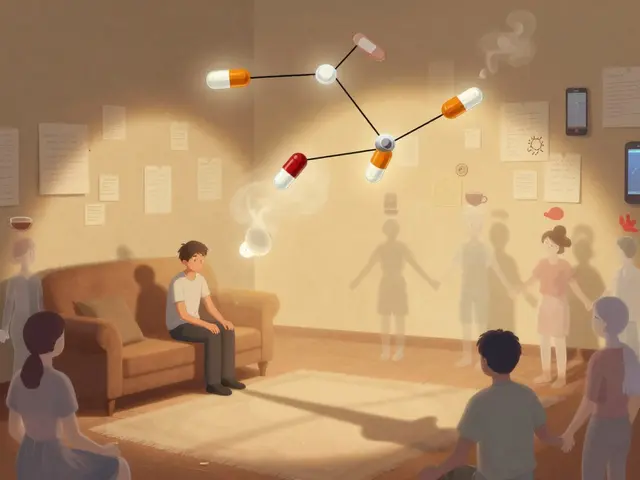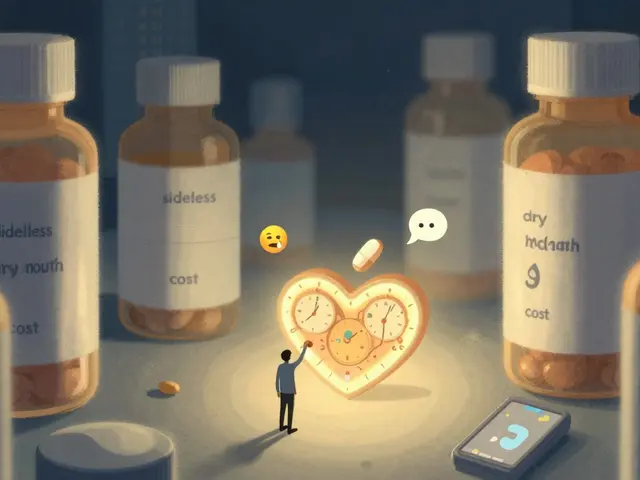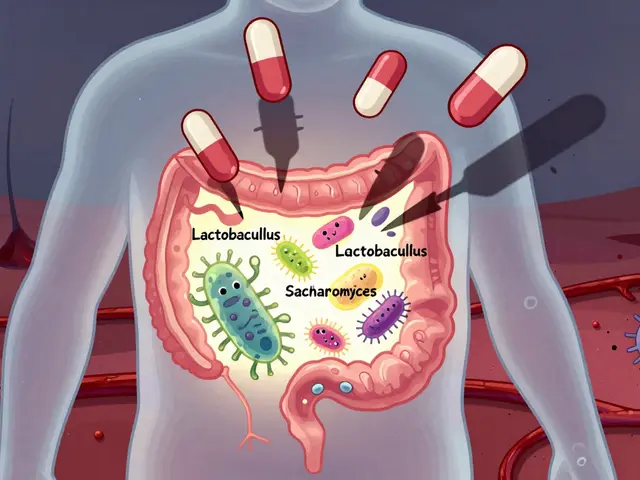
AUD Medication Comparison Tool
Select your preferences below to find the most suitable AUD medication:
Acamprol is a brand name for acamprosate, a medication approved to support abstinence in people with Alcohol Use Disorder (AUD). It works by modulating the glutamate system, helping to reduce post‑detox cravings and improve the chances of staying sober. Typical dosing is 666mg three times daily, taken with meals, and the drug is cleared primarily by the kidneys, making dose adjustments necessary for impaired renal function.
Why compare Acamprol with other AUD medications?
Clinicians and patients often ask: "Is Acamprol the best choice, or should I look at alternatives?" The answer depends on several factors - mechanism of action, side‑effect profile, cost, and individual health status. By laying out the key attributes of the most common alternatives, you can match a medication to your personal circumstances rather than relying on a one‑size‑fits‑all approach.
Mechanisms that matter
Understanding how each drug works helps predict which symptoms it will target.
- Acamprol modulates glutamatergic neurotransmission, restoring the balance between excitatory and inhibitory signals after alcohol withdrawal.
- Naltrexone is an opioid receptor antagonist that blocks the rewarding effects of alcohol.
- Disulfiram inhibits aldehyde dehydrogenase, causing unpleasant flushing if alcohol is consumed.
- Baclofen acts on GABA‑B receptors to reduce cravings and anxiety associated with abstinence.
- Gabapentin binds to the α2δ subunit of voltage‑gated calcium channels, dampening hyperexcitability during withdrawal.
- Topiramate inhibits excitatory neurotransmission and enhances GABA activity, lowering the urge to drink.
Clinical efficacy in real‑world settings
Large‑scale trials and meta‑analyses (e.g., Cochrane 2023, WHO 2022) show modest but consistent benefits for all these agents when combined with psychosocial support. Acamprol shines in patients who struggle mainly with cravings rather than reward‑driven drinking, while naltrexone is superior for those who binge for euphoria. Disulfiram’s efficacy hinges on strict adherence - it works best for highly motivated individuals who keep the medication in sight.
Side‑effect profiles you need to know
Side‑effects often dictate whether a patient stays on therapy.
- Acamprol - gastrointestinal upset (diarrhea, nausea), rare skin rash.
- Naltrexone - nausea, headache, occasional liver enzyme elevation (monitor if >50U/L).
- Disulfiram - severe flushing, tachycardia, low blood pressure if alcohol is ingested.
- Baclofen - drowsiness, dizziness, possible withdrawal seizures if stopped abruptly.
- Gabapentin - sedation, peripheral edema, off‑label abuse potential.
- Topiramate - cognitive “brain fog,” paresthesia, weight loss, kidney stones.

Cost and accessibility in 2025
In Australia, generic acamprosate is priced around AUD80 for a month’s supply, while naltrexone and disulfiram are roughly AUD30-45. Baclofen, gabapentin, and topiramate are all under AUD20, but they are off‑label for AUD, requiring specialist justification. Insurance coverage (Medicare+private plans) often favors the cheaper off‑label drugs, though a doctor’s prescription for acamprosate is usually reimbursed under the Pharmaceutical Benefits Scheme (PBS).
Comparison table
| Medication | Mechanism | Typical Dose | FDA/TFDA Status (2025) | Common Side‑effects | Average Monthly Cost (AUD) |
|---|---|---|---|---|---|
| Acamprol | Glutamate modulation | 666mg×3=1998mg | Approved for AUD | Diarrhea, nausea | ≈80 |
| Naltrexone | Opioid‑receptor antagonist | 50mgonce daily | Approved for AUD | Nausea, headache | ≈35 |
| Disulfiram | Aldehyde dehydrogenase inhibitor | 250-500mgonce daily | Approved for AUD | Flushing, tachycardia | ≈30 |
| Baclofen | GABA‑B agonist | 30mg×3=90mg | Off‑label for AUD | Drowsiness, dizziness | ≈15 |
| Gabapentin | Calcium‑channel modulator | 300mg×3=900mg | Off‑label for AUD | Sedation, edema | ≈12 |
| Topiramate | GABA enhancer & glutamate blocker | 100mgonce daily (titrated) | Off‑label for AUD | Cognitive fog, paresthesia | ≈18 |
How to choose the right medication
Think of medication selection as a decision tree:
- Assess renal and hepatic function. If creatinine clearance < 30mL/min, Acamprol dose must be halved or avoided; naltrexone may need liver monitoring.
- Identify the dominant craving type. Glutamate‑driven cravings point toward Acamprol; reward‑driven urges suggest naltrexone.
- Consider adherence style. If you need a deterrent effect, Disulfiram’s aversive reaction can be powerful.
- Evaluate comorbidities. Anxiety‑dominant patients may benefit from baclofen’s calming GABA‑B action, while those with neuropathic pain might already be on gabapentin.
- Factor in cost and insurance. If out‑of‑pocket expense is a barrier, the cheaper off‑label options become attractive, provided a specialist signs off.
Discuss these points with a prescribing clinician; shared decision‑making improves retention by up to 30% according to a 2024 Australian cohort study.
Practical tips for starting Acamprol
If you decide Acamprol is the best fit, follow these steps for a smooth start:
- Complete a medical clearance focusing on kidney function (eGFR ≥60mL/min is ideal).
- Take each dose with a meal to reduce GI upset.
- Maintain a daily log of cravings and any side‑effects - this data helps the prescriber adjust dosage.
- Combine the medication with at least one psychosocial component: CBT, mutual‑help groups, or motivational interviewing.
- Schedule a follow‑up visit after 2weeks to assess tolerability and reinforce adherence.
Related concepts and next steps
Understanding Acamprol’s place in the broader AUD treatment landscape opens doors to deeper knowledge. Topics you may want to explore next include:
- Motivational Interviewing - a counseling style that boosts medication adherence.
- Withdrawal Management - how detox protocols set the stage for maintenance meds.
- Genetic Testing for AUD - emerging evidence on how ADH1B and OPRM1 variants influence drug response.
- Telehealth Support - remote monitoring tools that improve follow‑up rates.
These areas deepen the conversation beyond the pill, creating a holistic recovery plan.

Frequently Asked Questions
Can Acamprol be taken with other AUD medications?
Yes, in many cases Acamprol can be combined with naltrexone or a psychosocial program, but clinicians usually avoid pairing it with other glutamate‑targeting agents like topiramate due to overlapping side‑effects. Always check kidney function before adding drugs.
How long does it take to see a reduction in cravings?
Most patients notice a modest decline within 2-3 weeks of consistent dosing. Full benefit may require 8-12 weeks, especially when paired with counseling.
Is Acamprol safe for people with liver disease?
Acamprol is primarily excreted by the kidneys, so it is generally safe for mild‑to‑moderate liver impairment. Severe hepatic dysfunction does not usually affect its clearance, but regular liver function tests are recommended when using naltrexone.
What if I miss a dose of Acamprol?
Take the missed tablet as soon as you remember, unless it’s almost time for the next dose. In that case, skip the missed one - don’t double‑dose.
Are there any dietary restrictions while on Acamprol?
No strict restrictions, but taking the tablets with food reduces GI upset. Limit high‑salt foods if you have hypertension, as the formulation contains a small amount of sodium.
How does the efficacy of Acamprol compare to naltrexone?
Meta‑analyses show similar overall abstinence rates, but the patient profile matters: Acamprol excels for craving‑dominant cases, while naltrexone is better when the reward pathway drives drinking.
Can I use Acamprol if I’m pregnant?
Safety data in pregnancy are limited. The precautionary approach is to avoid it unless the benefits clearly outweigh potential risks, and only under specialist supervision.






10 Comments
Hey folks, just wanted to drop a quick note about how Acamprol fits into the bigger picture of AUD treatment. First off, the glutamate‑modulating action makes it a solid choice for people whose cravings feel like a constant low‑grade buzz rather than a reward chase. It’s especially handy if you’ve got kidney concerns, because it’s cleared renally and doesn’t hit the liver as hard as naltrexone. That said, you still need to check your eGFR before you start, otherwise you might end up with too high a dose and some nasty GI upset. The dosing schedule (666 mg three times a day) can feel like a chore, but taking it with meals usually keeps the diarrhea at bay. I’ve seen patients who missed a dose here and there and still kept their cravings under control, as long as they get back on track quickly. Pairing Acamprol with some CBT or mutual‑help group really boosts the odds – the meds handle the biology, therapy tackles the behavior. If you’re on a tight budget, the generic version in Australia runs about AUD 80 a month, which is pricier than baclofen but often covered by PBS if you have a legit prescription. For those who struggle with anxiety‑driven cravings, you might still consider baclofen as an adjunct, but watch out for drowsiness and potential seizure risk if you stop cold turkey. The side‑effect profile of Acamprol is pretty mild – some nausea, maybe a rash, but nothing as dramatic as the flushing you get with disulfiram. When you’re deciding between naltrexone and Acamprol, think about whether the urge to drink is more about the reward buzz or the constant urge to fill a void; that’ll point you toward the right med. Long‑term studies show that staying on Acamprol for at least three months gives you the best chance of maintaining abstinence, especially if you keep a cravings diary to track progress. Lastly, don’t forget to re‑check kidney function every few months – kidneys can change over time, and you don’t want to overload them. Good luck, and remember that medication is just one piece of the recovery puzzle – community, mindset, and self‑care are just as vital.
/p>Looks like a textbook brochure.
/p>I appreciate the thorough breakdown of each medication’s mechanism, especially the glutamate vs. opioid pathways. It’s useful when explaining options to patients from different cultural backgrounds who may have varying beliefs about cravings. The cost comparison for Australia is a nice touch, though I wish there were more data on insurance coverage in the US. Also, highlighting the need for renal monitoring with Acamprol helps avoid potential pitfalls. Overall, the table makes quick reference easy.
/p>Great summary! 😊 I’ve seen Acamprol work wonders when paired with weekly peer‑support meetings. The only hiccup for me was remembering the three‑times‑daily schedule, but setting phone alarms helped a lot. Keep the info coming – it really helps newbies navigate these choices.
/p>Ah, the classic “choose a pill and you’re set” vibe. Sure, the table is pretty, but real life isn’t a spreadsheet. You can’t just toss a baclofen prescription on someone with anxiety and call it a day – the sedation alone can ruin a morning routine. And let’s not forget that off‑label use sometimes feels like a legal loophole, not a best‑practice recommendation. If you’re looking for a one‑size‑fits‑all, you’ve missed the point entirely.
/p>Thanks for the breakdown i think its helpful for people who are just starting out the side effect info especially is useful for deciding what might work best for you also i like the tip about taking it with meals it really does help with nausea
/p>Really? You actually think baclofen is a "nice" off‑label option, huh?; the sedation alone can turn a productive day into a foggy nightmare,; plus the withdrawal seizures if you quit cold-hardly "nice"; perhaps you should read beyond the glossy marketing sheets before preaching colorful vocab.
/p>Interesting points! 😊; I wonder how the cultural context influences patients' acceptance of glutamate‑modulating meds; maybe in some societies the idea of "brain chemistry" is more accepted than an "opioid blocker"; the table does a great job of laying out the facts,; looking forward to more discussions on real‑world adherence!
/p>While the article looks polished, have you considered that the pharmaceutical industry might be pulling the strings behind these "recommendations"? The "generic" pricing could be a smokescreen for hidden subsidies. Also, the emphasis on renal clearance seems oddly specific-perhaps they're nudging us toward certain labs that benefit their own interests. Just a thought, but keep an eye out for the fine print.
/p>From a clinical standpoint, the comparison is fairly accurate. Acamprol's renal excretion indeed makes it preferable for patients with liver issues, whereas naltrexone requires hepatic monitoring. The side‑effect profiles listed align with trial data, and the cost overview matches current Australian PBS listings. It would be beneficial, however, to include patient-reported outcomes to capture real-world tolerability. Overall, a solid reference point for clinicians.
/p>